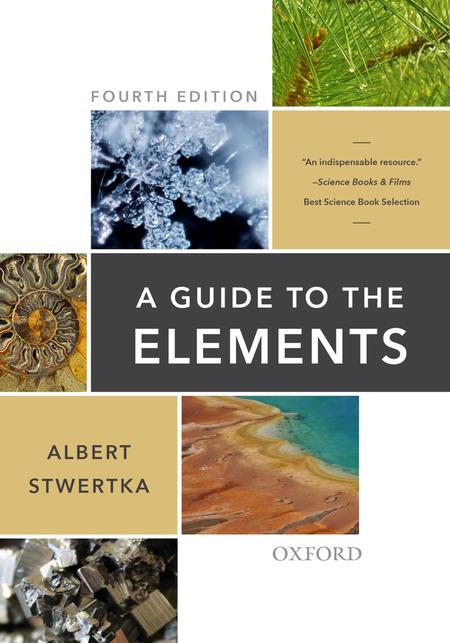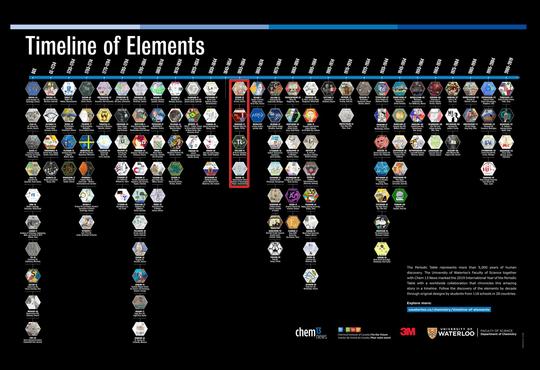 A Guide to the Elements, Fourth Edition, by Albert Stwertka, 2018, 263 pages, softcover, ISBN 978 0 19 068235 4 $24.95 USD
A Guide to the Elements, Fourth Edition, by Albert Stwertka, 2018, 263 pages, softcover, ISBN 978 0 19 068235 4 $24.95 USD
With the plethora of books on the periodic table, what makes Stwertka's worth reading? There are a number of reasons why you might want to obtain this book and keep it handy as a ready reference.
Shunning a foreword or introduction, Stwertka launches the book in science mode with a brief history of the construction of the periodic table. He follows this with short explanations of the nuclear atom, isotopes and then moves into the modern periodic table and modern atomic structure. While the chemistry teacher or student will certainly glean more from this particular book, one immediately recognizes that Stwertka's writing style is easy, readable, and understandable by a wider audience.
After this brief foray, Stwertka begins his trek through the periodic table, consecutively, beginning with hydrogen, element 1 and ending with oganesson, element 118. He concludes with an epilogue, a glossary, a chronology of discovery of the elements1 and a section on additional reading and websites. All of this is approached with succinctness and clarity, but without sacrificing understanding.
What makes A Guide to the Elements useful for the chemistry teacher is the small snippet on each element. It is the rare chemistry teacher who thoroughly knows every element, and for the rest of us, there is much to learn. From who is credited with the discovery, to the various sources of the element, to how it is isolated, and finally to reactions and uses, each brief overview is crammed with fascinating details.
With 118 elements, there are just too many highlights to mention; however, some stand out. For example, even an element as common as lithium has numerous uncommon uses. A surprising one involves isotope lithium-6 and the fusion bomb. As you might expect, there is an incredible amount of information for carbon, nitrogen and oxygen; but you might be surprised to learn how airlines feed oxygen to those little masks that fall from the ceiling should there be a drop in cabin pressure. While many teachers will use BF3 as an example of a trigonal planar molecule, it has a surprising capability. Additionally, many will also include molecules containing the noble gases, xenon and krypton for expanded valence and molecular shapes. Now you can include argon.
The sections on the lanthanides and the actinides are very eye-opening. Not only are these rare earth elements rarely included in the high school syllabus, they are likely not very well known to most chemistry teachers. How the valence electrons fill in these elements is surprising, and this explains why their properties are so very similar and why they were so difficult to isolate. You might be surprised to learn that many of these metals are highly reactive to both oxygen and water; yet they never appear in the metal reactivity series! Neodymium and samarium can be used to make super magnets which find use in generating electricity in wind turbines. And many of the rare earth elements are essential for the touch screens on our phones and tablets.
Other elements of note include krypton and cesium which define the metre and the second respectively, osmium which has a gaseous oxide and gold for how it is purified. As a final example, Stwertka explains the toxicity of radioactive gaseous radon-222. This isotope of radon has a very short-half life; however, one of its eventual daughter isotopes, lead-210, has a much longer one. It is this radioactive by-product that is significantly responsible for lung cancer in cigarette smokers and miners of uranium.
For the human-made transuranium elements, as well as the superheavy ones that complete the seventh period, Stwertka highlights the race to discover them. We are privy to the competition between labs in Berkeley, California, Dubna, Russia and Darmstadt, Germany to lay claim to these discoveries and thus have both bragging and naming rights. With multiple claims (many erroneous), the IUPAC (International Union of Pure and Applied Chemistry) is tasked with deciding what data to accept. Finally, with elements 114 to 118, there was actual cooperation between these competing labs as multi-national teams worked together to achieve success. You also begin to understand why Glenn Seaborg and Yuri Oganessian have been honoured with symbols in their lifetime.
A Guide to the Elements can be very useful for the chemistry teacher. Besides, providing excellent background on elements he or she may not be very familiar with (and others more familiar as well), it can be a starting place for students in the communication and application goals of the Ontario curriculum. One option could be to assign a random element to each student to present to the class. The student can simply use the information in A Guide to the Elements or could add additional research material as his or her curiosity allows. Moreover, if you delve into nuclear chemistry, the bombardment of various isotopes with projectiles to create super heavy atoms would be of interest as would their identification via the decay products.
Stwertka's A Guide to the Elements is an excellent option for the chemistry teacher. Certainly the theory of a nuclear island of stability will provide a teachable moment as will the variability of average atomic mass for many elements. If you travel to the sandy beaches in Florida over March break, you may be stepping on the mineral monazite, which contains a decent percentage of thorium in addition to numerous rare earth elements. Finally, if nothing else, you will learn the origin of the phrase "mad as a hatter".
Reference
- A graphical version of this can be found in the excellent Chem 13 News series, International Year of the Periodic Table:
https://uwaterloo.ca/chem13-news-magazine/december-2018-january-2019/feature/2019-international-year-periodic-table-update,
https://uwaterloo.ca/chem13-news-magazine/february-2019/feature/ancients-and-alchemists,
https://uwaterloo.ca/chem13-news-magazine/march-2019/feature/discovery-elements-miners,
https://uwaterloo.ca/chem13-news-magazine/april-2019/feature/true-elements-lavoisier-and-phlogiston







